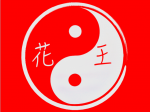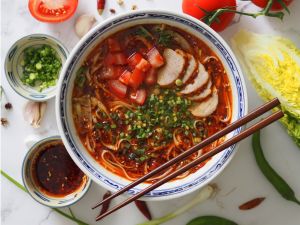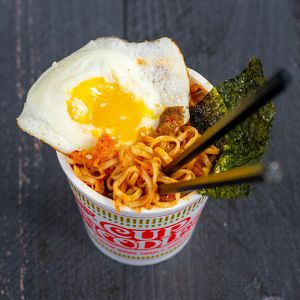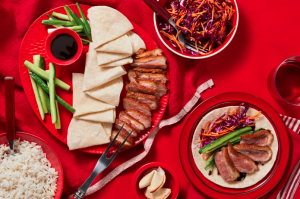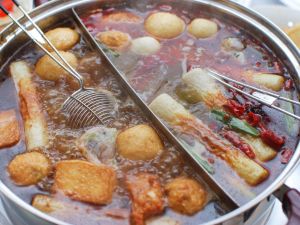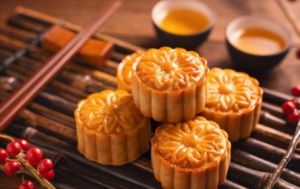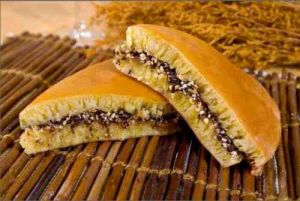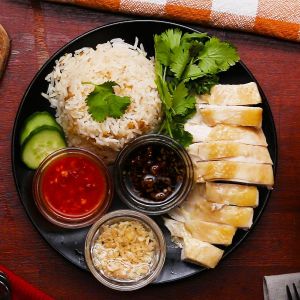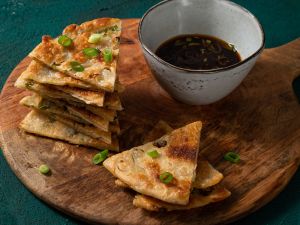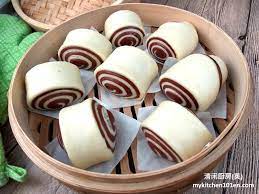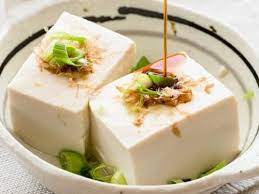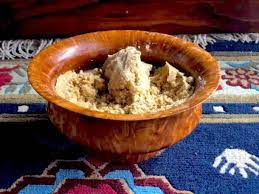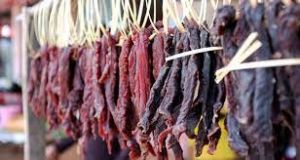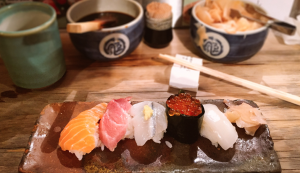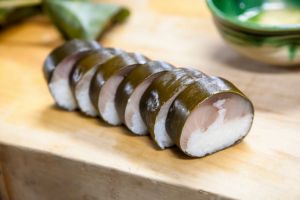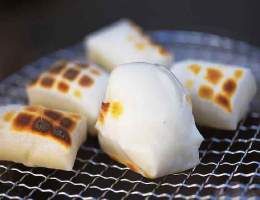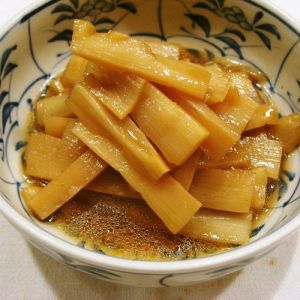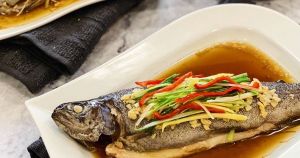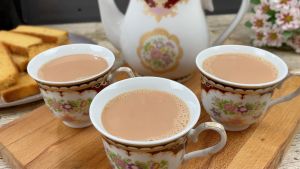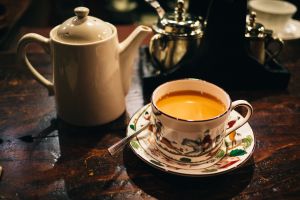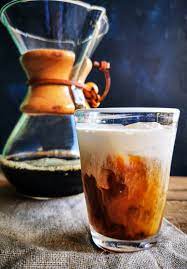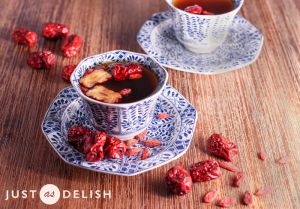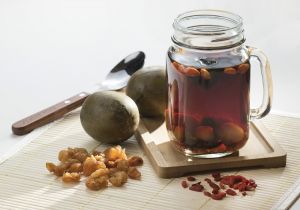Huawan (Pacifica)
The Peocracy of Huawan 花王派尼克帝国 | |
|---|---|
Motto: 神の霊を守れ! "Protect God's Spirits!" | |
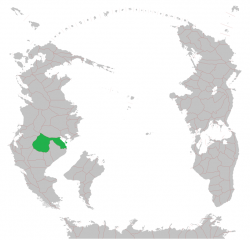 Location of Huawan in Pacifica | |
| Location | Midwest Cordilia bordered by the Xiongwei Mountains, Kringalian Strait and the South Pacific Ocean |
| Capital | Lián |
| Largest city | XinYue |
| Official languages | Huayu, Kotomoto, Shanyu Arabic |
| Demonym(s) | Paeonisian |
| Government | Unitary peocracy Semi-Absolute Monarchy |
| The Peony, Doctor Yan | |
| Lord Sima Yi | |
| Lord Kim Sol | |
| Lord-Admiral Zheng He | |
| Lady-Miss Diao Chan | |
| Lady Renatta Yokosuki | |
| Legislature | Parliament |
| Royal Council | |
| People's State Council | |
| Formation | |
• Bronze Age Pre-Imperialist Nomads | 2200 BCE |
• Hsi-Hsia Khanate | 600 BCE |
• The SongHwa Empire | 543 |
• The SeonDeok Empire | 875 |
• Altan Khanate | 1038 |
• LiuSong Dynasty | 1220 |
• The Feng Empire | 1380 |
• Taizong Dynasty | 1522 |
• Pax Paeonica | 1540 |
• Huawang Dynasty | 1721 |
• The Peocracy of of Huawan | 24th of April 1781 |
| Area | |
• Total | 490,793 km2 (189,496 sq mi) (2) |
| Population | |
• 2022 census | 100,784,428 |
• Density | 205/km2 (530.9/sq mi) |
| GDP (nominal) | 2022 estimate |
• Total | $3.469 trilion (6th) |
• Per capita | 34,830 (18th) |
| Currency | Huawan Tiol/Kuai (HTK) |
| Time zone | UTC-2 (CCT) |
| Date format | dd/mm/yyyy |
| Mains electricity | 230 V–50 Hz |
| Driving side | left |
| Calling code | +33 |
| World Forum Code | PE/PEH |
| Internet TLD | .hw |
Huawan (Chinese: 花王 pinyin: Huāwān), officially the Unitary Peocracy of Huawan (Chinese: 花王派尼克帝国 pinyin: huā wáng pài ní kè dì guó) is a sovereign state located in the Cordillera Region of The South Pacific, its sovereign territories including Mainland Huawan sitting on the midwest of the Cordillera region. The Mainland of Huawan is situated between the Xiongwei Mountains inthe west, Mt. Kalkara in the north and the Gulf of Kringalia in the east. The Mainland shares its borders with UPRAN on the North Hystagia in the northwest, Valkyria on the northeast, Villiakmon on the west, Songren on the southeast. The Peocracy of Huawan characterized itself as a Peocracy, which characterizes itself as a semi-absolute monarchy with a philosophical constitution. Its Head of State is called the Nuwang, or known simply as The Peony. Currently holding such title is doctor Yan, who has reigned since 2016 following the 2015 impeachments. The Peocracy's capital is Lian, regarded as an important centre for classical Peonic fine arts and culture, such as textile, drama, literature, music, poetry and visual arts. Renowned as a centre of Peonic education, Lian is home to the largest population of students as well as the home of Lotus University, the oldest surviving university in The South Pacific. The city also hosts an urban area with a total population of 4.1 million which shares the nation's iconic lush forests and natural wonders. The Peocracy consists of four countries: Huawan, ZhangHai, FuYuan and the Macintosh Islands. Their capitals are Lian, ZhangHai, Giacarta and Southport, respectively. The Mainland have their own governments based on prefectures within provinces, however ZhangHai, FuYuan and the Macintosh Islands have their own devolved governments. FuYuan and the Macintosh Islands are technically client states of the Peocracy being Royal dependencies with the Peonic government responsible for defence, international representation and further requested agreements made, each with varying powers. Other major cities include XinYue, Shengji, Wei Sheng, XinXian, Hai Lan, Hai Men, Hokkien, Nayong, Mianping, ZhangHai and Giacarta.
Traces of history in Huawan dates back to the Bronze Age, with several empires and dynasties ranging from nomadic tribes to prosperous economical powers. Its independence dates on 24th of April 1761 after the War of the Red Moon. Huawan is notable for its lush forests, clean air and tall mountains, with the highest point of the region lying in the permafrost Xiongwei Mountains. Huawan is also prominent for its keen interest in environmentalism and sustainable development, as well as sharp interests in healthcare and scientific research, where it is a leading voice in the region for medicine and medical research. It is also famous for its agriculture industry, where the country commands the region's tea, coffee and rice trade. Huawan is also home for the first High Speed Rail, known as the Shinkansen, and a frighteningly efficiently extensive railway network as well as home of the first supersonic passenger jetliner, the CM SST.
At its height in the 16th century of the Taizong Era led by Raina Taizong, the empire commanded the seas between the east and west where prominent trade and piracy provided influence can be observed in the language, culture and political systems of many of states such as Laiwan, ZhangHai and Valora. Huawan currently possess a high-income economy and a very high human development index rating, ranking 3rd in the world. It was the world's first in healthcare and life expectancy.. The Peocracy remains a great power, with considerable economic, cultural, military, scientific and political influence internationally. It has the sixth in military expenditure in the world.
The country is also famous for its naval superiority, commanding the regional seas for centuries in piracy, trade and exploration. Notable for its gigantic treasure ships, floating cities 135 metres long and 55 metres wide. Beginning from the piracy of The Peony, Mangling Mangsten, and growing traction under The Peony, Shao Yan, noted infamously as the pirate queen of the known world. Piracy by the country plagued the region for centures, with its fleets rivaling those of countries with much more superior technology. The nation commanded the seas between the 14th to the mid 19th century, and restarted its firm grasp in the 21st century, holding an strong navy alongside The Kingdom of Sedunn. The nation is also famous for its part in the Great War, fighting against the Democratic Allies and The Imperialists before expelling Imperial hold on the Cordillera.
The end of the Great War also saw Huawan with rapid industrialization and weariness for Allied influence in the region. The rapid proliferation of nuclear missiles in Huawan in 1957 brought to the beginning of the Iron Century, seeing coalition blocs united under various mutual pacts and government treatises. During the Iron Century Huawan produced many significant social and technological achievements and innovations. It had one of the the world's largest economy, and the Peonic Armed Forces comprised the largest standing military in the world. An TPNW-designated state, it possessed the largest arsenal of nuclear weapons in the world until its dismantling. It was a founding member of the WF as well as one of the leading chairs in the organization. From the end of The Great War until its dissolution, the country maintained its status as one of the region's superpowers, alongside Ryccia, The Frost Empire, Besern, Sedunn and Sallodesia, through its hegemony in Central Cordilia, military and economic strengths, aid to developing countries, fast infrastructural development, naval superiority and scientific research.
History
Recent
Geography
Climate
Flora and fauna
Politics
Government
Government Buildings
| Name | Designation | Location | Description | Picture |
|---|---|---|---|---|
| Royal Palace of Lian | Royal Government Palace, National Government Office | Lian, Royal Province | Constructed in the Huawang dynasty upon the end of the Feng dynasty. It became the royal house of the Peonic royal family as well as the central office of government. However, when the era of the Shogunate came along, efforts to decentralize power in Lian came to play. As such, the Royal Palace now become the office for the High Diplomat, the High Commodore, the Royal Premier, the Royal Exchequer, the Imperial Military Advisor.
|
|
| Devotion Hall | Main Hall of Ministries | Sheng Ji, Royal Province | The Devotion Hall is the office | |
| Ryoko Stronghold | Defense and Military Council Headquarters | Kenyama, Royal Province | The Central Military Headquarters of Huawan is sited in Ryoko Stronghold, which also houses the Military Museum of Huawan. While it is not the central command post, it is the main office for the five Peonic militaries. The Armed Forces, the Royal Navy, The Air Service, PRiM2 and the Expeditionary Forces. | |
| Central Hall | Office of the Central Government | Xin Xian, Central Province | For the Central government headquarters, as well as the office of the Central Government. The Central Governor hall houses the Central Governor and the Central Council of Administrators. The Central Hall is located in ZeShui and used to be the merchant's hall in the Feng Dynasty. It also houses the museum of Royal History. | |
| Eastern Hall | Office of the Eastern Government | Hai Lan, Special Region Hai Lan | For the Eastern Government, sited in Hai Lan it is a fairly new structure. The office was the old office of the maritime chancellery and the High Commodore. However, the office is moved to Port Serenade and the Eastern Government is sited in the old office of the maritime chancellery until the Governor is elected. As such the office currently houses the transitional government for the Eastern Region. | |
| The Court of Huawan | Lower Legislative Assembly, People's Council | XinYue, Royal Province | The DanYang Castle was the Highest Judicial Palace of the Masako Dynasty as well as the symbol of tyranny in Peonic History. The internal areas of the palace were filled with riches and gold that it was a mark of an extreme oligarchy and separation of the rich and the poor. Upon the Huawang dynasty, Empress Mangling Mangsten ordered that the DanYang Castle became a place of equality. Thus became the Court of Huawan, and the birth of the People's Council. The People's Council is akin to the Lower House of Legislature
The People's Council is a united voice of the Peonic state. But there are three chambers in the People's Council to divide the discussion into different regions. The Central Chamber, The Eastern Chamber and the Cooperation Chamber. The Central Chamber discusses the Central Region, The Eastern Chamber discusses the Eastern Region and the Cooperation Chamber houses various representatives from all the Peonic Cooperatives. |
|
| Ancestral Hall | Upper Legislative Assembly, Royal Council | Sheng Ji, Royal Province | The Royal Council, which is the upper house of the legislature that deliberates any edicts that would pass and its membership appointed by the Royal Premier based on applications. The Ancestral Hall housed the Royal Council and the office of The Royal Premier. It is amongst one of the oldest structures in Huawan, and its structure is chosen for its humility. | |
| Taiyo Court | Supreme Court | Lian, Royal Province | The Supreme Court of Huawan is governed in the Taiyo Court. The building is called Taiyo because the heat of the sun could warm people in a spirited defense, or burn the criminals in brutal prosecution. The building is rather new and was introduced in Akane Yan's rule, the Taiyo Court is sited in Lian. |
Political parties
Law and judicial system
Administrative divisions
Foreign relations
Military
Economy
Agriculture
Tourism
Energy
Infrastructure
Science and technology
Demographics
Urban areas
Language
Religion
Education
Healthcare
Immigration
Famous Sedunners
Culture
Value system and society
Holidays
Literature
Arts
Music
Cinema
Media
Architecture
Cuisine
Foods of Huawan
| Name | Description | Image |
|---|---|---|
| LaMian | The noodle is made by twisting, stretching and folding the dough into strands, using the weight of the dough. La Mian literally means pulled noodles. It's broth is usually chicken stock, beef stock, vegetable stock, or pork stock. The La Mian is one of the most famous meals in the Peocracy, eaten in every weather every time. Some broth are either savory, spicy or sweet. Usage of artificial taste enhancers are seen as "cheating" and a complete insult to the customers. One must never cut LaMian, as the uncut lengthy noodles symbolizes longevity to those who eat it. | |
| BeiMian | La Mian also has a more instant counterpart, BeiMian, or cup noodles, has been a revolutionary dish in modern day Huawan. With various advancements in preservatives, cup noodles prepared by just adding water, has been a favorite. Several types of Cup Noodles featured preserved real meat as well. Cup noodles are heavily regulated by the state, as preservatives needed to preserve these noodles are sometimes quite volatile and unhealthy. The usage of artificial taste enhancers are close to naught. (Not in public knowledge, The Peony is a secret fan of cup noodles) | |
| Linic Duck | Linic Duck is a duck dish from Huawan that has been prepared since the imperial era. The meat is characterized by its thin, crisp skin, with authentic versions of the dish serving mostly the skin and little meat, sliced in front of the diners by the cook. Ducks bred specially for the dish are slaughtered after 65 days and seasoned before being roasted in a closed or hung oven. The meat is eaten with scallion, cucumber and sweet bean sauce with pancakes rolled around the fillings. Sometimes pickled radish is also inside, and other sauces (like hoisin sauce) can be used. It has been percieved as the royal dish of royal members, since the independence, the Linic duck is available commercial consumption. The Linic duck symbolizes fertility, wealth, and honor. | |
| Hot Pot | Hot pot is a popular communal dish that consists a simmering metal pot of stock at the center of the dining table. While the hot pot is kept simmering, ingredients are placed into the pot and are cooked at the table. Typical hot pot dishes include thinly sliced meat, leaf vegetables, mushrooms, wontons, egg dumplings, tofu, and seafood. The cooked food is usually eaten with a dipping sauce. Hot pot meals are usually eaten in the winter during supper time. The complete dish provides two types of stock, one spicy (Red) and one sweet (white). The idea of two very different flavors represents Yin and Yang. | |
| Yuèbĭng | A mooncake is a Peonic pastry traditionally eaten during the Lunar Festival. The festival is for lunar appreciation and moon watching, when mooncakes are regarded as an indispensable delicacy. Mooncakes are offered between friends or on family gatherings while celebrating the festival. The Lunar Festival is one of the four most important Peonic festivals. A rich thick filling usually made from red bean or lotus seed paste is surrounded by a thin (2–3 mm) crust and may contain yolks from salted duck eggs. Mooncakes are usually eaten in small wedges accompanied by tea. Today, it is customary for businessmen and families to present them to their clients or relatives as presents. | |
| Muttabaq | The Mutabbaq is one of the most popular street foods and one of the oldest, in par with the entry of Islam into the Peocracy. The cooking method, dough (which uses yeast and baking soda) and ingredients (usually Vanilla extract is added as essence) has a consistency more like a crumpet. While it is baked on a pan, the martabak is spread with butter or margarine, sugar, crushed peanuts, chocolate sprinkles, cheese or other toppings. Before serving, the martabak is folded in half, so the toppings get in the middle of martabak. This extremely sinful dish is one of the most popular and favorite meals ever in Huawan. | |
| Huawanic Chicken Rice | Huawanic chicken rice is a dish adapted from early settlers and pirate from a faraway land. The chicken is prepared in accordance with traditional Peonic methods, which involve poaching the entire chicken at sub-boiling temperatures. The resulting stock is skimmed off and some of the fat and liquid, along with ginger, garlic and pandan leaves are used in the cooking of the rice, producing an oily, flavourful rice sometimes known as "oily rice". The chickens are fed with coconut and peanut bran. During the last two months before going to market, they are kept in coops above the ground. Chefs prefer using older, plumper birds to maximise the amount of oil extracted, thus creating a more flavourful dish. Over time, however, the dish began procuring other elements, such as using younger birds to produce more tender meats. In Northern Huawan, the bird is dipped in ice after cooking to produce a jelly-like skin finishing, commonly referred to as báijī (白雞; "white chicken"), while Western Huawan notably omits this step. Chicken prepared by braising – lǔjī (滷雞; "stock chicken") – or roasting – shāojī (燒雞; "roasted chicken") – may also be used. The dish is served with a dipping sauce of freshly minced red chilli and garlic, usually accompanied with dark soy sauce and freshly ground ginger. Fresh cucumber boiled in the chicken broth and light soy sauce with a dash of sesame oil are served with the chicken, which is usually served at room temperature. The Symbol of Rice means fertility, luck, wealth, as well as a link between Sky (God) and Earth (Men) | |
| Cōngyóubǐng | A scallion pancake (Chinese: 葱油饼; pinyin: cōngyóubǐng; Mandarin pronunciation [tsʰʊ́ŋi̯ǒu̯pìŋ]) is a Peonic savory, unleavened flatbread folded with oil and minced scallions (green onions). Unlike Sedunnic pancakes, it is made from dough instead of batter. Variations exist on the basic method of preparation that incorporate other flavors and fillings. | |
| Mantou |
|
|
| Dòufǔ | Dòufǔ, literally known as bean curd or Tofu, is a food made by coagulating soy milk and then pressing the resulting curds into soft white blocks. It is a staple component in Peonic cuisine. Tofu can be soft, firm, or extra firm. Tofu has a subtle flavor and can be used in savory and sweet dishes. It is often seasoned or marinated to suit the dish. However, Peonic beancurds are so well made, eating them raw with salted soy sauce has become a wonder food. The Tofu symbolizes fulfillment of wealth and happiness | |
| T'sampa |
|
|
| Borts | Borts are air-dried meat cut into long strips which are hung in the shade. The Peonic nomadic lifestyle and the local climatic conditions gave rise to specific methods of preserving meat. The most widespread one is air-drying or bortsloh. After about a month the meat is dry, having turned into small, hard, wooden-like sticks with a brown color. The volume has shrunk so much that the meat of the original cow can now easily fit into the stomach of that same cow. The dried borts is broken into small pieces or ground to a coarse and fibrous powder. It is stored in a linen bag, which allows contact with air. In the dry climate of Huawan, this method of storage preserves the quality of the meat over months, or even years. Borts are more nutritious, and said to be tastier, than other modern field rations. There is an unconfirmed method from old times: Peonic nomads relied on borts for months-long journeys. Dried carefully for three years and then ground into a fine powder, the borts could fit through a sieve or into a cow's bladder, and also feed three to four people with the amount of a single pinch. | |
| Fresh Sushi and Sashimi | ||
| Hai Lan Style Sushi | ||
| Grilled Mochi | ||
| ZhuSun |
|
|
| Qīngzhēng yú | ||
| LaCha | Cha: The Oldest and Most traditional beverage to date. The practice of drinking tea has a long history in the Peocracy, having vastly established there. Cha generally represents tea leaves which have been processed using methods inherited from ancient Huawan. The beverage is considered one of the seven necessities of Peonic life, along with firewood, rice, noodles, oil, salt, soy sauce and vinegar. Cha is also used for medicinal purposes. By far, Cha has the strictest rules when it comes to etiquette in consumption, to a point that there is even a university major for one to become a proper brewster. | |
| LaCha | One of the most common beverages in Peonic culture, and it's sweetness is favored amongst children and teenagers. Sometimes the LaCha is infused with red ginger to give it a bit of spicy flavor. LaCha is a hot milk tea beverage which can be commonly found in restaurants and outdoor stalls. Its name (Literally means Pulled Tea) is derived from the pouring process of "pulling" the drink during preparation. It is made from black tea, condensed milk or evaporated milk. | |
| Kafei | ||
| Huángjiā bīng kāfēi | ||
| ChongYinPin | A traditional drink made by combining dried dates and several fruits to create multiflavored beverage. It is most common to find ChongYinPin in street markets and carnivals, they are usually warm to combat the everlasting winter in Huawan. Their fragrance and fruity taste is quite loved. | |
| LoHanGuo | Luo Han Guo is used for medicinal purposes. It is a healing remedy for relieving throat inflammation, chronic cough, balancing the heatiness in the body, constipation for the elderly and it’s also used as a form of a natural sweetener in some food. Its sweetness leaves something to be desired for daily consumption however. |
